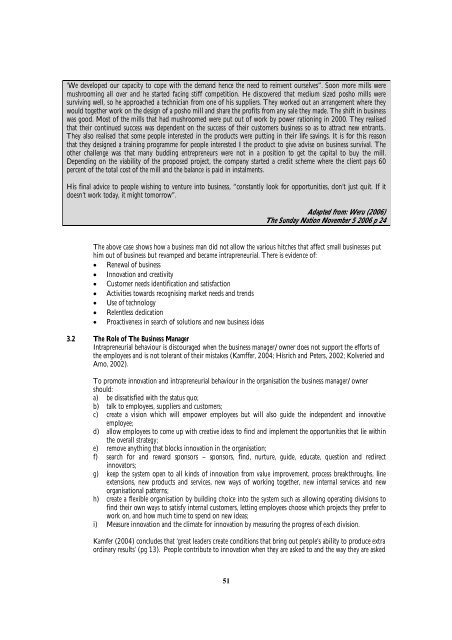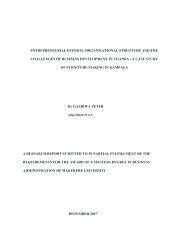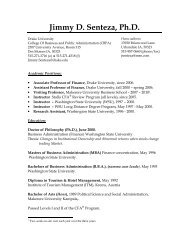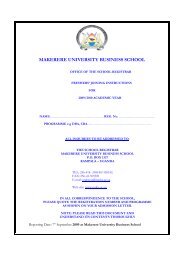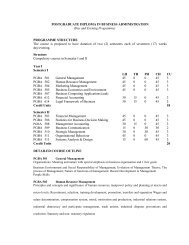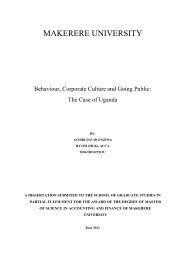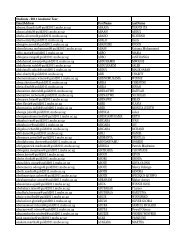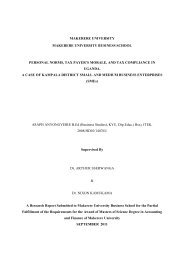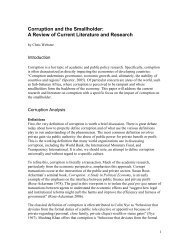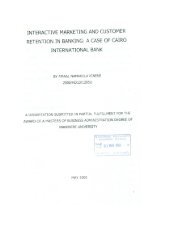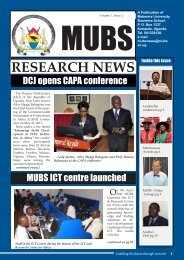13th Annual International Management Conference Proceeding
13th Annual International Management Conference Proceeding
13th Annual International Management Conference Proceeding
You also want an ePaper? Increase the reach of your titles
YUMPU automatically turns print PDFs into web optimized ePapers that Google loves.
‘We developed our capacity to cope with the demand hence the need to reinvent ourselves”. Soon more mills were<br />
mushrooming all over and he started facing stiff competition. He discovered that medium sized posho mills were<br />
surviving well, so he approached a technician from one of his suppliers. They worked out an arrangement where they<br />
would together work on the design of a posho mill and share the profits from any sale they made. The shift in business<br />
was good. Most of the mills that had mushroomed were put out of work by power rationing in 2000. They realised<br />
that their continued success was dependent on the success of their customers business so as to attract new entrants..<br />
They also realised that some people interested in the products were putting in their life savings. It is for this reason<br />
that they designed a training programme for people interested I the product to give advise on business survival. The<br />
other challenge was that many budding entrepreneurs were not in a position to get the capital to buy the mill.<br />
Depending on the viability of the proposed project, the company started a credit scheme where the client pays 60<br />
percent of the total cost of the mill and the balance is paid in instalments.<br />
His final advice to people wishing to venture into business, “constantly look for opportunities, don’t just quit. If it<br />
doesn’t work today, it might tomorrow”.<br />
51<br />
Adapted from: Weru (2006)<br />
The Sunday Nation November 5 2006 p 24<br />
The above case shows how a business man did not allow the various hitches that affect small businesses put<br />
him out of business but revamped and became intrapreneurial. There is evidence of:<br />
� Renewal of business<br />
� Innovation and creativity<br />
� Customer needs identification and satisfaction<br />
� Activities towards recognising market needs and trends<br />
� Use of technology<br />
� Relentless dedication<br />
� Proactiveness in search of solutions and new business ideas<br />
3.2 The Role of The Business Manager<br />
Intrapreneurial behaviour is discouraged when the business manager/owner does not support the efforts of<br />
the employees and is not tolerant of their mistakes (Kamffer, 2004; Hisrich and Peters, 2002; Kolveried and<br />
Amo, 2002).<br />
To promote innovation and intrapreneurial behaviour in the organisation the business manager/owner<br />
should:<br />
a) be dissatisfied with the status quo;<br />
b) talk to employees, suppliers and customers;<br />
c) create a vision which will empower employees but will also guide the independent and innovative<br />
employee;<br />
d) allow employees to come up with creative ideas to find and implement the opportunities that lie within<br />
the overall strategy;<br />
e) remove anything that blocks innovation in the organisation;<br />
f) search for and reward sponsors – sponsors, find, nurture, guide, educate, question and redirect<br />
innovators;<br />
g) keep the system open to all kinds of innovation from value improvement, process breakthroughs, line<br />
extensions, new products and services, new ways of working together, new internal services and new<br />
organisational patterns;<br />
h) create a flexible organisation by building choice into the system such as allowing operating divisions to<br />
find their own ways to satisfy internal customers, letting employees choose which projects they prefer to<br />
work on, and how much time to spend on new ideas;<br />
i) Measure innovation and the climate for innovation by measuring the progress of each division.<br />
Kamfer (2004) concludes that ‘great leaders create conditions that bring out people’s ability to produce extra<br />
ordinary results’ (pg 13). People contribute to innovation when they are asked to and the way they are asked


